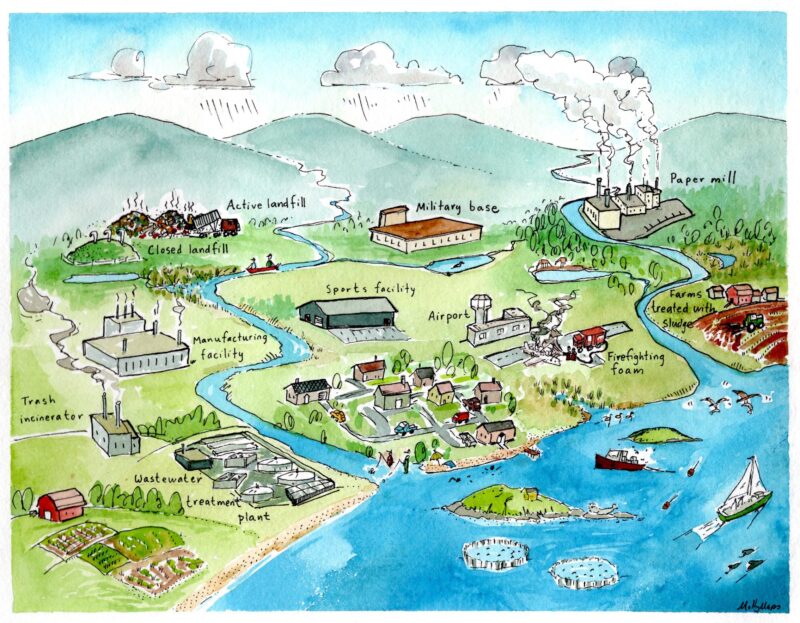A small jet boat slapped along the Penobscot River, prompting a flock of ducks to lift off from the water just below an outfall pipe of the ND Paper mill in Old Town. A team from the Penobscot Indian Nation’s Department of Natural Resources was headed out to gather water-quality data.
Having spent more than two decades monitoring pollution in the watershed, Jan Paul, the Penobscot Nation’s water resources technician, said she no longer eats duck, fish or many other traditional tribal foods. For her and for Daniel Kusnierz, the Nation’s water resources program manager, one of the hardest aspects of their work is helping tribal members navigate the risks of contaminated fish and riverine plants.
“Wild foods are important to the tribe,” Kusnierz said. “It’s who the Penobscots are.”

How much PFAS is entering the river and the full range of potential sources remain unclear due to lack of systematic water testing. But one primary contributor appears to be landfill leachate — rainwater that has collected chemicals as it percolates through layers of waste.
The ND Paper mill and several wastewater treatment plants along the Penobscot River routinely discharge a mix of wastewater and landfill leachate. “Leachate is loaded with PFAS,” said Laura Orlando, a civil engineer and adjunct professor at the Boston University School of Public Health.
“Wastewater facilities and industrial plants with conventional primary and secondary treatment are not designed to manage PFAS,” Orlando said. The first treatment plant in Maine to pilot filteration of PFAS through tertiary treatment, Anson-Madison Sanitary District, is beginning that work this month, said its superintendent, Dale Clark.
At the federal level, PFAS remain largely unregulated despite growing evidence that even minute amounts can disrupt immunological, hormonal and reproductive systems, and may increase the risk of various cancers. Last month the U.S. Environmental Protection Agency (EPA) proposed that two of the estimated 4,700 PFAS in present or past commercial use be named hazardous substances under the federal Superfund program.
As lead once contaminated fuels, paints, pipes, pencils, pottery and more, PFAS permeate industrial and consumer culture. Given their capacity to reduce surface tension, and resist oil, grease and water, the chemicals are used in papermaking, shipbuilding, textile mills, leather tanneries and semiconductor production, as well as in household furnishings, automotive products, outdoor gear, medical supplies and even personal care products.
These uses pollute wastewater with PFAS, some of which collects in the sludge generated during water treatment. In Maine, most of that sludge will now head to landfills, following a recent ban on “land-applying” sludge, a decades-old practice that has caused widespread PFAS contamination. Far into the future, landfills will likely generate PFAS pollution, even after levels of these chemicals decline in the waste stream as Maine and other states require manufacturers to phase out PFAS use in products.
That prospect of ongoing contamination could endanger members of the Penobscot Indian Nation. Since Maine enacted a ban on commercial landfills in 1989, the state has acquired and licensed three landfills, all along a 50-mile stretch of land at the heart of the Penobscot Reservation.
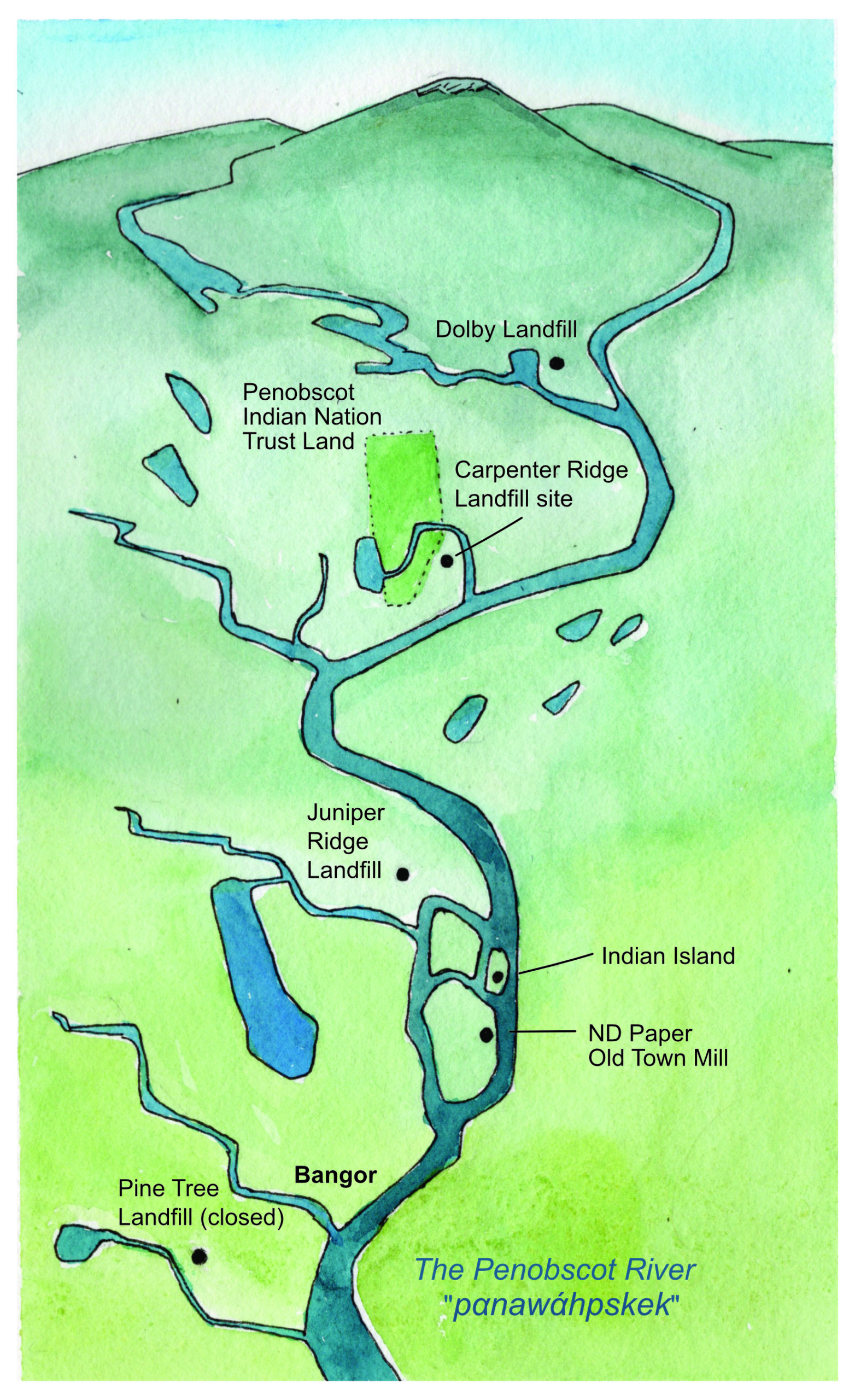
A river rimmed by landfills
Juniper Ridge is the largest state landfill, a 200-foot-high waste plateau perched five miles northwest of the Penobscot Nation’s home at Indian Island. Since the state acquired the landfill in 2004, it has been run by a Vermont-based firm, Casella Waste Systems, Inc.
PFAS levels in leachate are a direct reflection of the waste a landfill receives, said Samuel Nicolai, Casella’s vice president of engineering and compliance. A 2019 study Casella commissioned at its Vermont landfill, assessing waste materials expected to have some PFAS, found the compounds in 95 percent of the samples – particularly carpets, mattresses, furnishings and textiles. PFAS also enters landfills in construction debris, household waste and sludge.
Leachate at Juniper Ridge is collected through a system of pipes and pumped to a million-gallon storage tank on site. Each weekday, about five truckloads of the leachate are transported from the tank to the ND Paper mill, said Jeffrey Pelletier, an engineer with Casella, who estimates the total annual transport at 16 million gallons.
There the leachate mixes with mill effluent and undergoes secondary treatment before discharge into the Penobscot River, according to a 2019 permit issued by the Maine Department of Environmental Protection. At the mill, said Jeff McBurnie, director of compliance with Casella, there is “nothing that would qualify as treatment for PFAS.”
“We’re (all) trying to treat a problem we don’t have the guardrails for,” McBurnie added. “We haven’t been given the ability to manage (PFAS) because we didn’t know about them, and we can’t identify the scope of the problem because these materials are proprietary. Do I want to vilify a whole class of materials? I wouldn’t have to if some manufacturers were more forthcoming.”
(The Maine Monitor sought to visit the mill’s wastewater treatment facility and interview staff, but repeated calls and emails spanning several weeks to Scott Reed, ND Paper’s environmental and governmental affairs director, and Brian Boland, the company’s director of communications, went unreturned.)
In recent state-mandated PFAS testing of landfill leachate, Juniper Ridge Landfill reported high levels of several PFAS compounds, and a second state-owned waste facility in East Millinocket, Dolby Landfill, had the second-highest reading for PFOA (at 3,080 nanograms per liter), a commonly found PFAS, among the 41 landfills reporting. A closed private landfill in Hampden owned by Casella was among the top 10 for the highest combined level of the six PFAS measured. Its leachate goes to the Bangor wastewater treatment plant where it receives biological treatments before discharge into the river, said Amanda Smith, the city’s director of water quality management.
The leachate captured at Dolby is pumped to East Millinocket’s wastewater treatment facility, then discharged into the Penobscot River’s West Branch, said Blaine McLaughlin, the town’s water works utility superintendent.
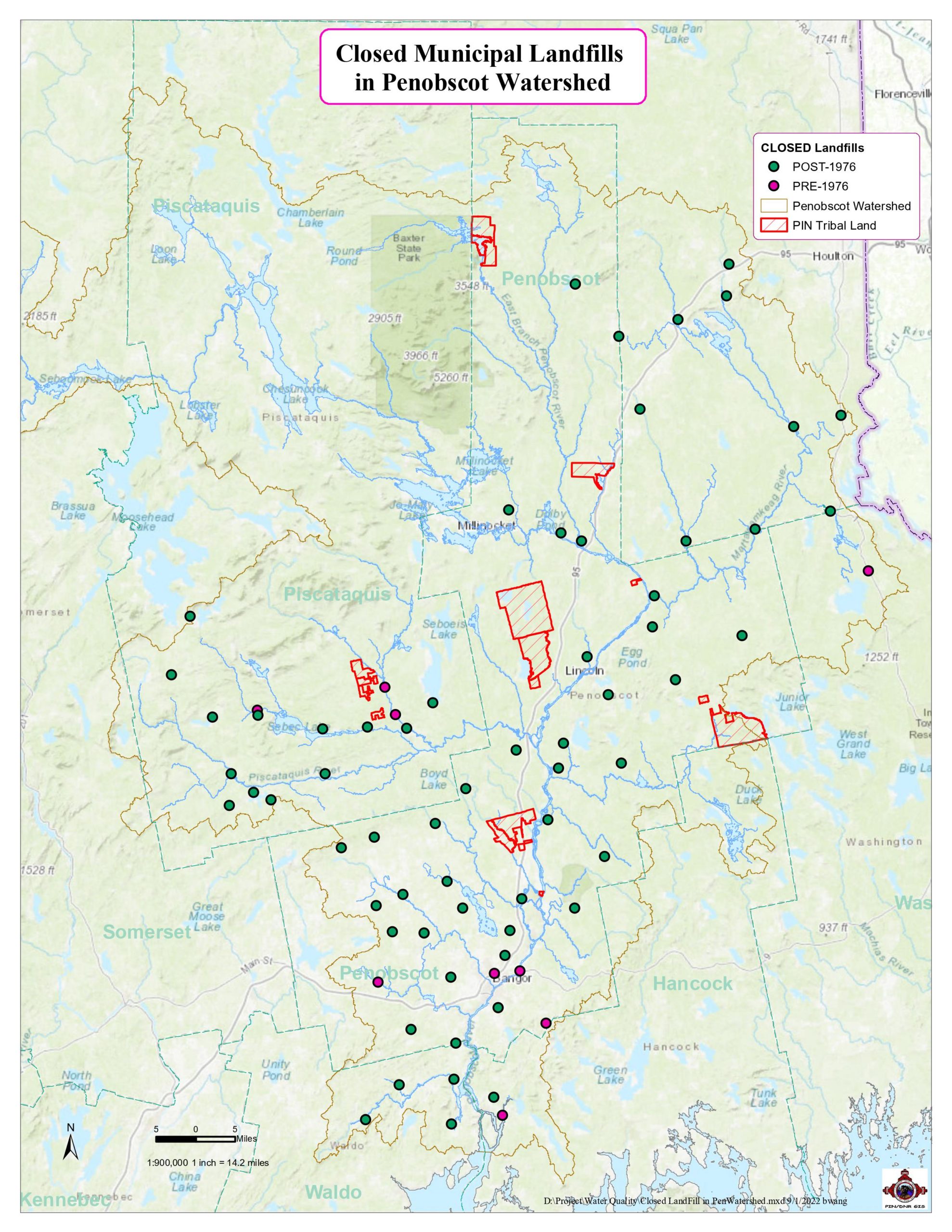
The Maine DEP has identified 72 closed landfills in the Penobscot River watershed as well (see map), many of them unlined old municipal dumps that could leak chemicals into tributaries. For example, the agency found PFAS when sampling monitoring wells in 2020 at Old Town’s closed municipal landfill near Pushaw Stream, according to David Madore, the DEP’s spokesperson.
Kusnierz is concerned about PFAS contaminants emanating from Dolby Landfill and other sites within the watershed. “We’re in the process of trying to identify all the different potential sources,” he said, including all the “old, unregulated places.”
A restoration effort thwarted
When PFAS surfaced as a concern, the Tribe and a diverse group of collaborators had recently completed a decades-long effort to remove two dams from the Penobscot River, allowing the return upstream of sea-run fish. It was a major step toward restoring the health of the river ecosystem, which Kusnierz said is the “lifeblood of the Penobscot Nation.”
As large numbers of sea-run fish began returning to the river, the Tribe wanted to know whether they were safe to eat. In response, federal agencies undertook a study of contaminant levels in Penobscot River sea-run fish that included PFAS.
In 2021, the federal Agency for Toxic Substances and Disease Registry reported back that the sea-run fish contained PFAS, in addition to mercury, dioxins and PCBs. One PFAS compound, PFOS, was found in four species at levels that might cause “adverse health effects,” the report noted. “With the dams out, we were so excited for the fish to come back,” Kusnierz said, “and then we learned they have all these contaminants in them.”
A 2015 EPA study warned that a range of chemical contaminant threats was undermining sustenance fishing rights the Penobscot Nation reserved through historic treaties and the 1980 Maine Indian Land Claims Settlement Act, rights reaffirmed when the tribe became a federally recognized Indian Nation that year. The report said “fish contamination prevents this right from being fully exercised, and may seriously threaten the health of community members and their traditional life ways.”
Now, Tribe members must confront the varied threats posed by PFAS, a vast class of chemicals in global use that remains largely untested. “The sea-run fish are more toxic than the river-run ones,” said Paul, the Nation’s water resources technician. “It’s crazy to think it’s just the river that’s polluted. The ocean is getting it from everywhere.”
The extent of PFAS pollution in Penobscot River water and in the broader watershed ecosystem remains unclear due to lack of systematic testing. To date, there are only a few isolated data points: For example, in 2020, biologists with the Maine DEP found relatively low levels of one PFAS compound, PFOS, in Penobscot River fish, and this summer the Shaw Institute (a scientific research organization in Blue Hill) found low concentrations of another PFAS compound, PFOA, in three of the four samples taken in the vicinity of Old Town. In response to questions about food web impacts, the Maine Department of Inland and Wildlife wrote that “there is insufficient data” for understanding how PFAS migrate into wildlife and affect the food web.
The idea seems to be that “’It’s OK to pollute just a little bit,’” Paul added, “but a little bit accumulates over time.”
In the case of PFAS, accumulations spanning more than 50 years could keep cycling through rainwater, soils, rivers, lakes, groundwater, bays and oceans for centuries.
‘It’s our responsibility’
The enduring toxicity of PFAS compounds represents a threat, not just to the health of tribal members but to traditions that bound them through millennia to the waterway they know as “pαnawάhpskek.” The river is central to their fishing, hunting and gathering traditions, to their spiritual practices and their creation stories.
“Our holy place is not in the Middle East but right here in our watershed,” said Darren Ranco, a member of the Penobscot Nation and a professor of anthropology at the University of Maine. “The river is a relation that is in many ways sacred; it’s not an ‘other,’ a resource. We will take care of it to the extent we can. It’s not about ownership; it’s our responsibility.”
That ancestral responsibility, carried down for more than 10,000 years, has manifested in the last 25 years in a tribal commitment to test waters at roughly 90 sites throughout the Penobscot River watershed and advocate for policies supporting the river.
Toxic pollution is “another legacy of harm from colonization,” Ranco said, with the potential risk of PFAS “particularly damaging because it is so difficult to address.” Colonization left Penobscot, Passamaquoddy, Micmac and Maliseet tribes with a tiny fraction of the territory Wabanaki people once occupied in the Northeast. A quarter of Maine falls within the Penobscot River watershed, but only the river and 200 islands remain in the Penobscot’s tribal care.
In 2012, the Maine Attorney General’s Office asserted that only the islands fell within the reservation, not the river, prompting a legal case that continues today. Intervenors on behalf of the state include many of the municipalities, sewer districts, paper mills and other industries that hold permits to discharge wastewater into the Penobscot River.
Following on historic land loss and the ongoing challenge to river ownership, the potential PFAS threat is “clearly unjust,” Ranco said. It can leave tribal members feeling overwhelmed by their inability to protect waters from contaminants, and sustain a livable home and traditional life ways.
“There’s a type of despair,” wrote Sherry Mitchell, a Penobscot attorney and activist in her book “Sacred Instructions,” “that is unique to those who are exiled on their own lands.”
Landfills leave a legacy
Seeking strong action on PFAS, Penobscot Nation members were encouraged by legislative action to contain chemical contamination. In the last session, that included a measure passed to end application of sludge onto farmlands and forests. With no known means to destroy PFAS, Kusnierz said, it makes sense to be “concentrating it in a more controlled environment.”
That contained setting will be Juniper Ridge Landfill for much of the PFAS-laden sludge generated statewide. The Tribe supported LD 1911, but also sought legislation to mitigate the impact additional sludge would have on the leachate load entering the Penobscot River by ensuring that leachate at state-owned landfills is treated for PFAS.
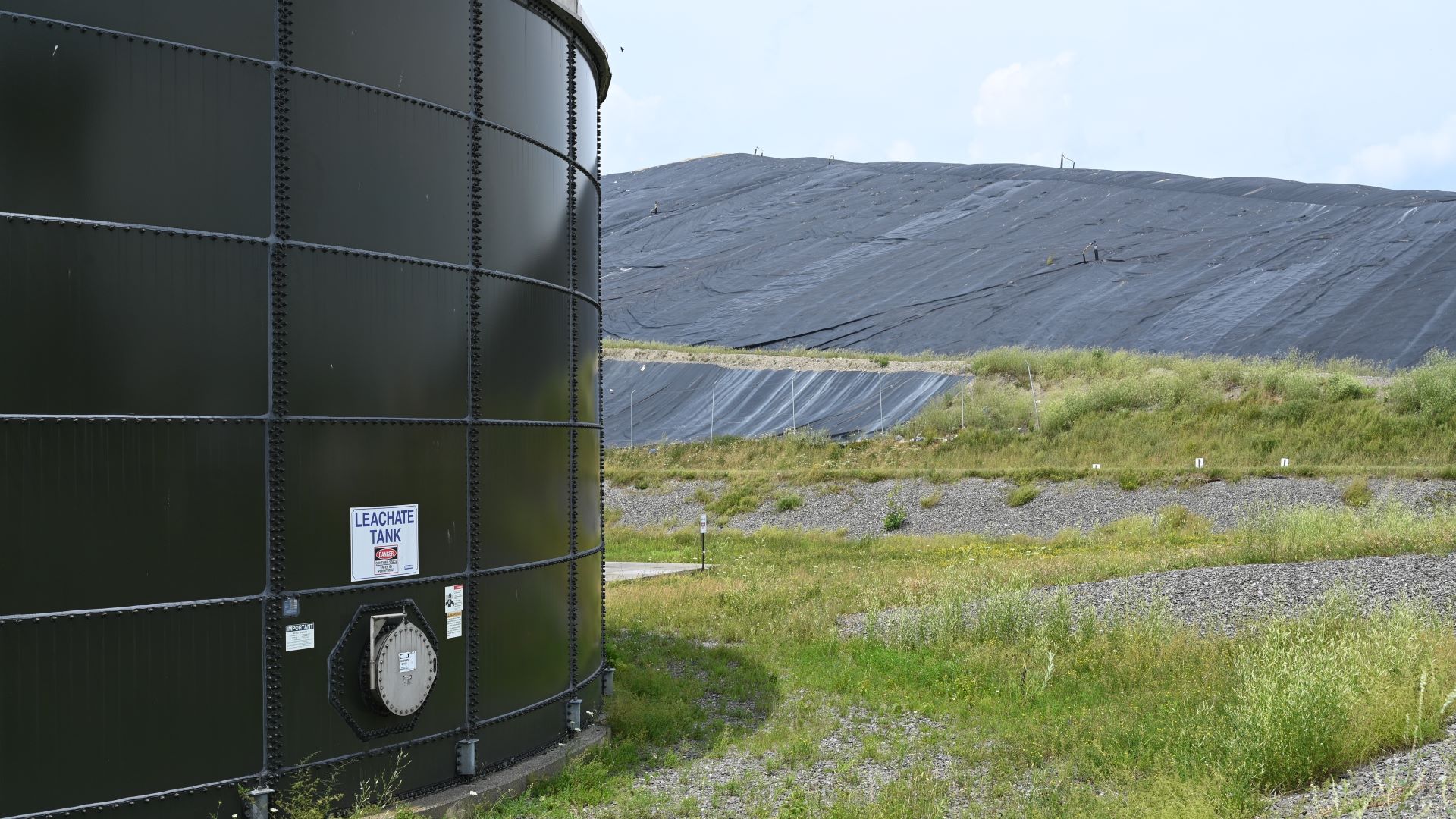
Midway between Juniper Ridge Landfill and Dolby Landfill, in a township just west of Lincoln, the state maintains an active permit on an undeveloped 1,500-acre site, Carpenter Ridge, that it calls “a potential ‘safety net’ for future landfill development.”
Juniper Ridge Landfill is expected to reach capacity in 10 to 12 years, Casella estimates. Then, “Carpenter Ridge will become the next Juniper Ridge,” Kusnierz fears, concentrating more PFAS-laden debris farther up the watershed.
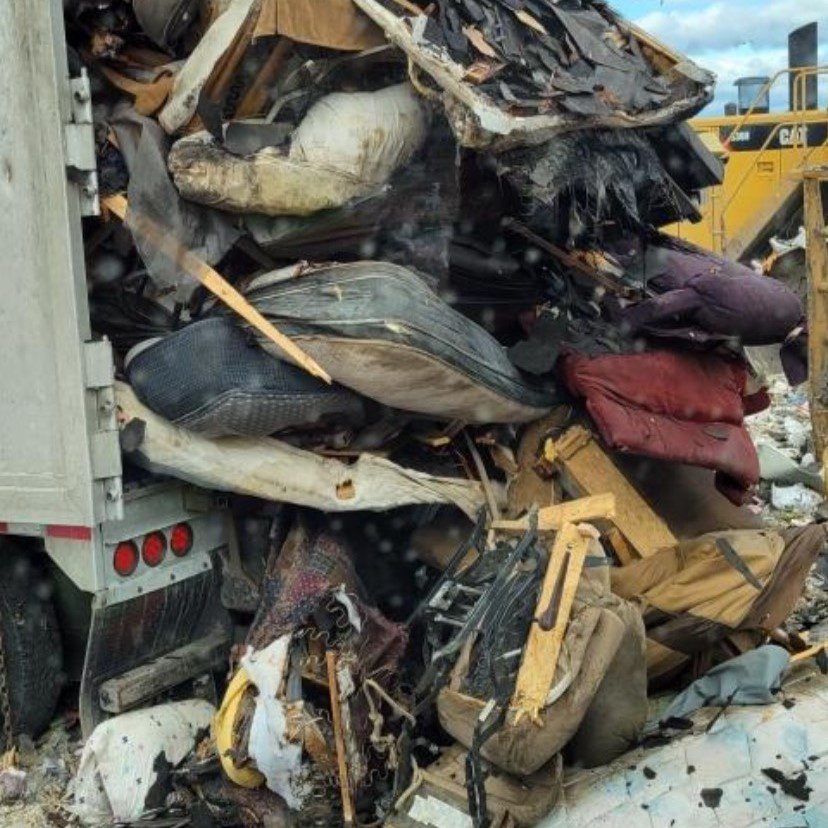
The Carpenter Ridge site, less than a mile from a large tract of Penobscot Nation Trust Land that tribal members use for hunting and fishing, lies close to Mattamiscontis Stream, where the Penobscot Nation has been working to restore fisheries.
“Landfills create environmental justice issues for generations,” Ranco said. A concentration of them near the Penobscot Reservation could turn lands and waters that the Tribe views as sacred into a “sacrifice area,” he added. “Once you build it and (the contaminated waste) comes, it becomes a legacy and a permanent violation of how we’re supposed to treat the earth.”
‘Disproportionate impact’
The state acquired Juniper Ridge, Dolby and Carpenter Ridge landfills through deals made with paper mills, which were located by the Penobscot River due to the need for water in manufacturing and for wastewater discharge. As for their proximity to the Penobscot Indian Reservation, “I’m not saying it was deliberate,” Kusnierz said, “but talk about disproportionate impact.”
Working on his work on PFAS with tribes nationwide, Kusnierz has noticed how indigenous people naturally take a more precautionary approach. “This idea of figuring out how much of a toxic chemical is acceptable is baffling,” he said. “For native people, you just don’t put things in without knowing the effects because the river is a living relative.”
In terms of any pollutant discharge, the burden of proof needs to be on chemical manufacturers to demonstrate that their products do no harm, Kusnierz added. With PFAS, “they created something before they knew how to deal with it. That feels like a really dangerous game to be playing.”
Submerged discharge pipes near the ND Paper Mill in Old Town. Video by Marina Schauffler.
Maine faces widespread contamination due to PFAS, “forever chemicals” in ubiquitous use and now polluting wells, public water supplies, farmland and food chains. This series explores the pathways by which PFAS cycle through Maine’s environment and the far-reaching repercussions these enduring chemicals will have.
This project was produced with support from the Doris O’Donnell Innovations in Investigative Journalism Fellowship, awarded by the Center for Media Innovation at Point Park University in Pittsburgh, Pa.

